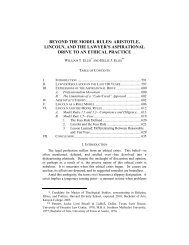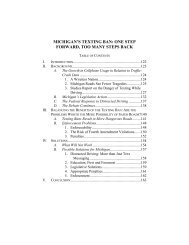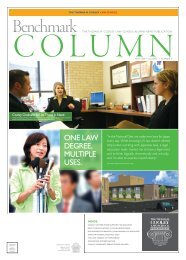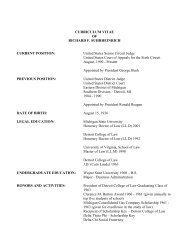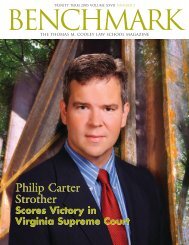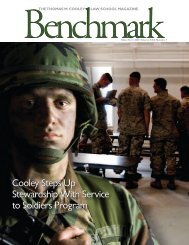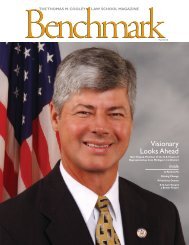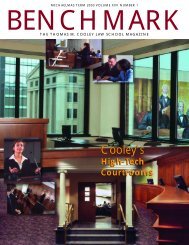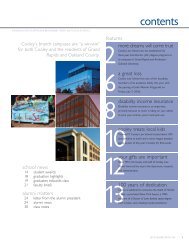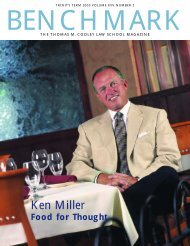Dennis E. Benner, Giving Back - Thomas M. Cooley Law School
Dennis E. Benner, Giving Back - Thomas M. Cooley Law School
Dennis E. Benner, Giving Back - Thomas M. Cooley Law School
You also want an ePaper? Increase the reach of your titles
YUMPU automatically turns print PDFs into web optimized ePapers that Google loves.
12 Michaelmas Term 2005steady support of public order.” “These are commonplaces,”Justice <strong>Cooley</strong> finished, “but the strength of law lies in itscommonplace character; and it becomes feeble and untrustworthywhen it expresses something different from the commonthoughts of men.”Justice <strong>Cooley</strong> was admonishing Justice Oliver WendellHolmes, Dean Christopher Columbus Langdell, and the otherBoston Brahmins and legal giants in the Harvard crowd.Langdell, who was promoting his new casebook method,rejoined <strong>Cooley</strong> that law was not to be learned from practicaleducation, experience, and apprenticeship, or from anexperienced lawyer, as <strong>Cooley</strong> had learned it, but was a scienceand “that all the available materials of that science arecontained in printed books.” For his part, Holmes laterrejected <strong>Cooley</strong>’s steadying commonplaces and insteaddescribed law as a “field for the lightning of genius” hopingthat from it “may fly sparks that shall set free in some geniushis explosive message.” In his final writing, “The Path of the<strong>Law</strong>,” Holmes wished that “every word of moral significancecould be banished from the law altogether” in favor of anamoral social science enabling the eugenics he favored.The rest is history. One might say that Langdell, not <strong>Cooley</strong>,won. At least, Harvard became the model for legal education.<strong>Law</strong> school, which students had entered immediately afterhigh school, gradually became a graduate school with a fouryear undergraduate degree generally required for admission.The law school curriculum gradually extended to three years.<strong>Law</strong> school eventually became mandatory for the bar as stateseliminated qualification by apprenticeship. Entering the professionrequires seven years of education, whereas in Justice<strong>Cooley</strong>’s day it had required none—only apprenticeship, committedreading, and practical examination.In addition to the credentialing of the profession and theenormous increase in entry cost, there was also a change inthe way law itself was taught. Langdell’s Socratic casebookmethod became the standard in which students read longstrings of cases with little guidance and much intimidationfrom the professor. (Langdell was said to frustrate his studentsto the point of apoplexy over his unwillingness toanswer questions.) Gone were <strong>Thomas</strong> <strong>Cooley</strong>’s clear lecturesand equally clear treatises, as well as the inalienablerights and ethical bases for law. In their place was aprocess-oriented form of legal analysis producing graduateswhom some scholars today call “amoral technicians”—readyto employ a discussion-closing rhetoric to achieve any clientend without much regard for the greater consequences.But did Langdell win? Although law’s professionalization certainlyserved the industrializing nation well, some studiessuggest that in today’s post-industrial society law schoolenforces a process and produces a product with which neitherthe student nor the public is very satisfied. Studentsreport that the ethical component they expected to find inAuthor’s note: Those wishing to know more of the legal,BENCHMARKlaw school is disappointingly absent. The profession is notparticularly pleased with graduates’ practical incapacity. Thepublic seems not much more satisfied with either lawyerintegrity or service. And there are serious questions whethera profession which so highly values technical skills and credentialsadequately serves its fundamental and historicaccess to justice role.Yet fortunately, there are still law schools like <strong>Cooley</strong> thatarticulate a values-based mission centered on knowledge,skills, and ethics. By offering evening, weekend, and yearroundclasses, law schools help students complete their educationmore quickly and without foregoing other earnings.When tuition is reasonable and students graduate with lessdebt, those graduates have greater opportunity to undertakethose eleemosynary missions which may have brought themto law school—to serve rather than to accumulate, engagingin the kind of widespread, disinterested, moral advocacy onwhich a democratic republic depends. Moreover, when lawschools employ practitioner-scholars as professors, requirerigorous writing courses, and offer clinical courses andexternships, they help students develop skills immediatelyuseful in practice. When they maintain academic resourcecenters offering voluntary supplemental educational seminarsand services, they help fit the education to the student. Whenthey offer professional exploration programs and meritbasedadmissions to large numbers of students, they offeraccess and promote diversity. And again, when they placeethics at the center of the law school curriculum, they allowthe student to retain the heart, mind, and soul with which toserve clients, community, and country.Duke University Professor Paul Carrington believes thatJustice <strong>Cooley</strong>, whom he calls the “elder to the republic,”offers the profession a post-modern archetype—that thecharacter traits Justice <strong>Cooley</strong> exhibited and ethic he taughtmakes him the model American professional for the 21stCentury. Whether that is true or not, Justice <strong>Cooley</strong>’s life continuesto inform and invigorate his namesake law schooland, we hope, enrich and guide its graduates.political, and spiritual culture that formed and continuouslyinformed Justice <strong>Cooley</strong>, and of how that culture still influenceslaw school, may consider reading: Paul D. Carrington,“The Common Thoughts of Men: The <strong>Law</strong>-Teaching andJudging of <strong>Thomas</strong> McIntyre <strong>Cooley</strong>,” 49 Stanford L. Rev.495 (1997); Paul D. Carrington, Stewards of Democracy:<strong>Law</strong> as a Public Profession (Westview Press 1999); <strong>Thomas</strong>M. <strong>Cooley</strong>, “Suggestions for the Study of <strong>Law</strong>” in <strong>Cooley</strong>’sBlackstone (4th ed., Callaghan and Co. 1899); <strong>Thomas</strong> M. <strong>Cooley</strong>, ARecord of the Commemoration on the 250th Anniversary of the Founding ofHarvard College 92-96 (John Wilson & Son 1887); Charles G. Finney,Lectures on Systematic Theology (4th ed. 1878 (reprinted Bethany 1994));Philip C. Kissam, The Discipline of <strong>Law</strong> <strong>School</strong>: The Making of Modern<strong>Law</strong>yers (Carolina Academic Press 2003); Francis Lieber, Legal and PoliticalHermeneutics (1838, reprinted Wm. S. Hein & Co. 1970); Robert Stevens,<strong>Law</strong> <strong>School</strong>: Legal Education in America from the 1850s to the 1980s (Univ.of North Carolina Press 1983).]




